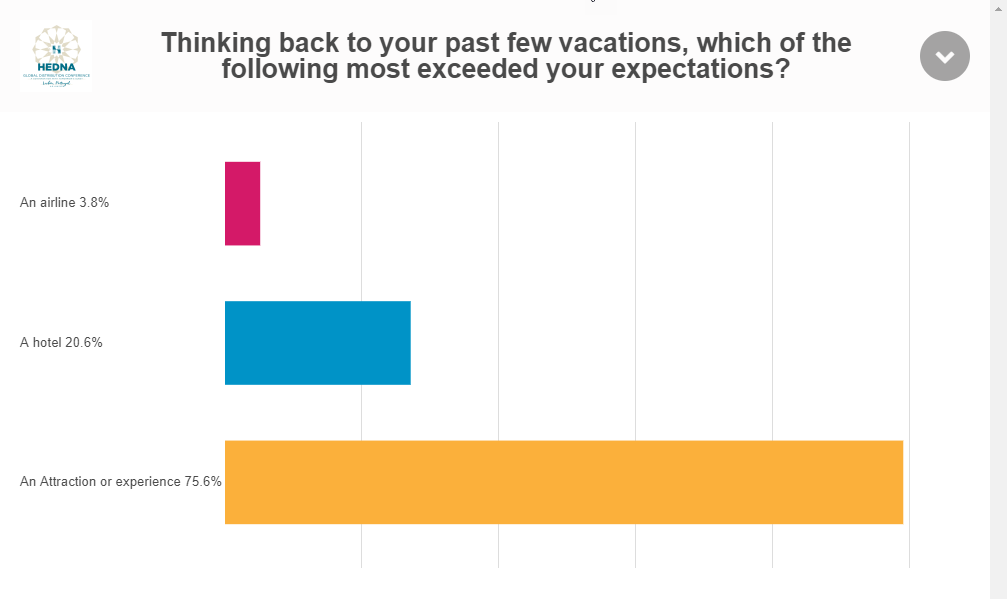Washington, DC (June 22, 2018) There were many perspectives on the state of global distribution featured across three days of education, keynotes, and deep-dive panel discussions. From iterating your business models to understanding how payments continue to evolve, here are 7 observations from in and around HEDNA Lisbon 2018.
On marketing to millennials – and anyone else online
The most vivid keynote of the week came from Steve Bartlett, the founder of social media consultancy Social Change. Beyond the prototypical inspirational founder story, Steve offered some very specific advice for brands defined success selling to consumers online.
While this wasn't a marketing conference, the reality of distribution is the digital channels (such as Instagram) are increasingly becoming bookable. This means those that sell online have to understand these emerging distribution channels. His advice:
- Become a publisher. well this advice has been standing for quite some time, successful brands these days know how to create content that resonates with their target audience, says Bartlett: “Branz they're winning set up internal teams as publishers, especially as Instagram shifts to bookings.”
- Facebook: Brands should encourage content the facilitates meaningful conversations on this platform.
- YouTube: Consider frequency, as daily videos ranked higher Windows that are one-off. Episodic content also performs well.
- Fertile ground: Bartlett mentioned both podcasts and LinkedIn as still “thriving with opportunities.”
On brands outside of hospitality doing retail right
Retailing and merchandising continue to be hot topics in hospitality. Looking to expand additional revenues, many hotels are looking for interesting ways to deliver more than just a room.
Kate Ancketill, of consultancy GDPR Creative Intelligence, offered a bevy of examples when attempting to answer the question “how to engage with tomorrow's customer?” Here are some standouts that audible enthusiasm from the crowd:
- The Museum of Ice Cream: this attraction was built with Instagram in mind. Offering only 30 minutes to explore, the space is full of interactive, memorable experiences — such as a giant pool of sprinkles. The attraction ended up garnering so much attention on social media, that it has now gone on tour.
- Delta and Tinder’s dating wall. Emerging from the insight that profiles with travel pictures were seen as more appealing, Tinder partnered with Delta to create a static dating wall that allow people to take more “sophisticated” pictures.
- Alibaba’s “New Retail” experience. The new food retail experience, called Nema, offers seven paths to purchase for different needs and use cases. This targeted approach to satisfying specific consumer needs with targeted products within the one operation allows for maximum profitability. The brand’s consumer group has different needs depending on the time of day and individual situation.
Emphasizing how these experiential campaigns made a viral impact, the takeaway was to brainstorm ways that hotels could leverage their physical assets for a viral effect.
On developing and maintaining a fruitful client/vendor relationship
During the “Hotelier’s View” panel, a group of hoteliers share their thoughts on how Hotels and their partner vendors can work better together.
One of the key points was addressing account management and account servicing. Sarah Fults, of MGM Resorts, made an important distinction between the definition of vendor versus partner. The choice of word informs the approach, as vendors might not have as much skin in the game as partners. Fults prefers to use partners, to emphasize that this is a mutual beneficial relationship.
However, many hoteliers, including some in the audience, felt that how their accounts for managed was a critical piece of satisfaction with any technology provider. From educating new hires to understanding the implications of new features, customer success was very important to hoteliers.
On pain points in payments
Payments continue to be a point of vigorous discussion, as the landscape’s complexity only seems to increase with time. When struggling to implement the variety of payments that consumers expect, there are a variety of things that create headaches for hotels.
As part of the standalone payments track, Mike Carlo, of ZanderPay, brought together a group of payment processors to share some of the hidden costs of payments for hotels.
“The biggest ‘hidden’ cost for the hotel industry is the lack of efficient payment processing for any cross-border guest. Whether it be cross-border fees charged by the card schemes or lack of transparency in FX conversions, hotels can pay 1 – 5% more than they should for any cross-border guests.”
On iterating new business models in an uncertain age
If there's one thing that all businesses share today, it's that the digital transformation has required evolving business models. This applies to the hospitality industry, as well as the vendors that serve it.
It’s all about “how to thrive when disruption has become the norm,” said Benjamin Devisme from Colossal Factory and Fernando Vives from NH Hotel Group. The quote that got the most reaction was that brands must
“Believe in your model more than you believe in god.”
This applies to both business models and algorithmic models. The point is you have to put the full weight behind whatever model you choose to build around.
Therefore, key criteria for successful models. Models must be:
1. Rationable: It's a blend of French and English but the point is that models must be rational and reasonable given current business circumstances. Irrational business models don't work, especially in an uncertain environment.
2. Shareable: If the model is not easy to share, it's likely not easy to understand. This complexity reduces the chance of success as the model is communicated throughout the value chain.
3. Challengeable: Your brand's team needs to be able to prod and push, and make sure but the model stands on its own. It should be resilient but also pliable whenever needed.
These observations are just one view into the many threads throughout the Lisbon event.
In the weeks and months ahead, we will be publishing an ongoing series that explores the themes, trends, and conversations of the conference. A refresher for those who were there, and a look inside for those who weren’t. Either way, the journey continues as we expand our scope towards understanding today’s constantly evolving distribution landscape.
Keep an eye out here on the HEDNA blog, as well as our LinkedIn page, for an ongoing series of articles around HEDNA Lisbon. Subscribe to our newsletter at https://www.hedna.org/members/blogs.asp



